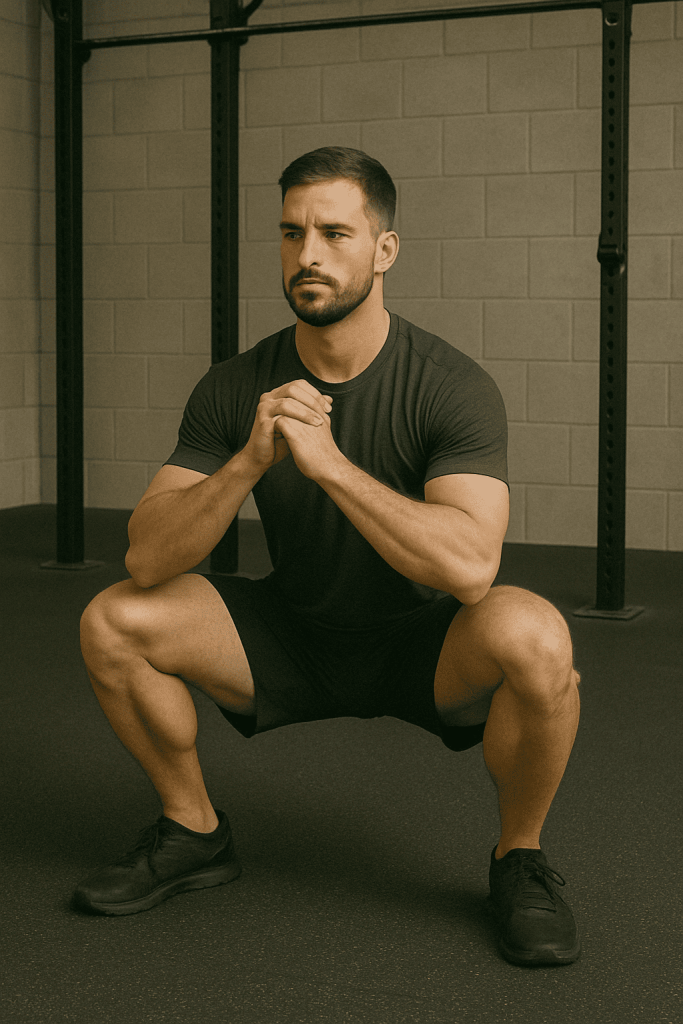2 de May de 2025
Sumo Squats: Exercise Guide, Tips and Benefits
Sumo squats are a powerful lower-body exercise that emphasize the inner thighs, glutes, and hips. With a wider stance than traditional squats, sumo squats improve hip mobility, strengthen stabilizer muscles, and offer a unique way to build lower-body power. Whether you’re training for strength, athletic performance, or better functional movement, sumo squats deserve a place in your workout routine.
What Are Sumo Squats?
Sumo squats are a variation of the standard squat where your feet are positioned wider than shoulder-width apart and your toes are pointed slightly outward. This stance shifts more emphasis onto the inner thighs (adductors) and glutes compared to a conventional squat. They are commonly used in strength and conditioning programs to develop functional strength, mobility, and stability in the hips and lower body.
How to Do Sumo Squats Properly
- Stand wide: Place your feet wider than shoulder-width apart, with toes turned out around 30 degrees.
- Engage your core: Brace your midsection and lift your chest.
- Add resistance if desired: Hold a kettlebell, dumbbell, or barbell close to your chest or hips.
- Lower your hips: Push your hips back and down, keeping knees tracking in line with your toes.
- Reach parallel or deeper: Pause when your thighs are at least parallel to the floor.
- Return to standing: Drive through your heels and squeeze your glutes at the top.
Tip: Don’t let your knees collapse inward—actively push them outward throughout the squat.

Muscles Worked by Sumo Squats
Sumo squats engage a wide range of lower body and stabilizing muscles:
- Gluteus maximus and medius: Main drivers of hip extension and pelvic stability.
- Adductors (inner thighs): Highly activated due to the wide stance.
- Quadriceps: Extend the knees during the upward phase.
- Hamstrings: Assist in hip extension and control.
- Core stabilizers: Help maintain trunk position and balance.
Benefits of Sumo Squats
- Targeted Glute and Inner Thigh Development: Great for building strength and symmetry in the lower body.
- Improved Hip Mobility: The wide stance opens the hips and enhances range of motion.
- Functional Strength Gains: Transfers well to sports and daily movement patterns.
- Joint-Friendly Variation: Less spinal loading compared to barbell back squats.
- Adaptable for All Levels: Can be loaded or modified depending on goals.
Common Mistakes to Avoid
- Letting Knees Collapse Inward: Always drive your knees outward to engage the glutes and protect your joints.
- Leaning Too Far Forward: Maintain an upright chest and neutral spine.
- Stopping Too Shallow: Aim for parallel or slightly below for full muscle activation.
- Poor Foot Alignment: Ensure knees and toes point in the same direction.
Variations of Sumo Squats
- Weighted Sumo Squat: Hold a dumbbell or kettlebell to add resistance.
- Pulse Sumo Squats: Perform short pulses at the bottom to increase time under tension.
- Sumo Squat with Calf Raise: Add a heel raise at the top to target the calves.
- Sumo Deadlift: A barbell-based variation starting from the floor, emphasizing posterior chain strength.

How to Include Sumo Squats in Your S&C Workout
Use sumo squats as a primary movement or accessory exercise in lower-body sessions. Program 3–4 sets of 8–12 reps, focusing on control and full depth. They complement movements like lunges, hip thrusts, and RDLs for a complete glute and hamstring workout. During intense training blocks, they also support better mechanics and reduce unnecessary fatigue, especially when using moderate loads.
FAQs About Sumo Squats
What are sumo squats good for?
They’re excellent for building glute, inner thigh, and hip strength while also improving mobility and postural control.
Are sumo squats better than regular squats?
Not better, just different—sumo squats emphasize the glutes and adductors more, while regular squats focus more on the quads.
How to properly do a sumo squat?
Stand wide, turn toes out, brace your core, keep your torso upright, squat down with knees tracking toes, then drive through your heels.
Do sumo squats actually grow glutes?
Yes, especially when performed with proper form and progressive overload. They strongly activate the glutes through a deep range of motion.
What do 100 sumo squats a day do?
They may boost endurance and mobility, but real strength and hypertrophy require structured progression and rest.
Sumo squats are a simple yet powerful tool for developing lower-body strength, improving mobility, and enhancing athletic performance. When included in a balanced strength and conditioning program, they can also help reduce fatigue by encouraging better movement patterns and muscle engagement without excessive load.
